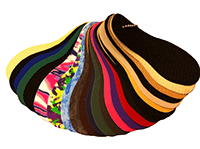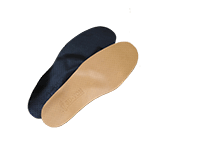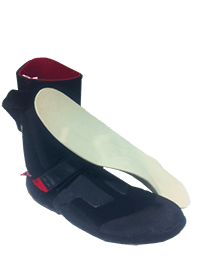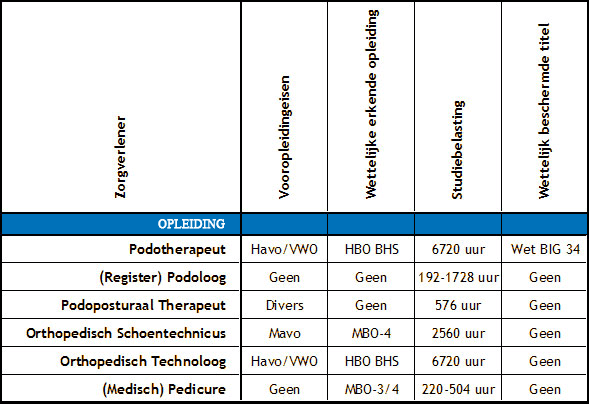Podiatry
What is podiatry and what does the podiatrist treat?
The profession of podiatrist
The profession of podiatrist is an essential part of the paramedical sector. The title “podotherapist” is a protected and regulated title. To be entitled to this title, one must successfully complete the 4-year full-time HBO course to become a podiatrist, which is only offered at two renowned institutions: the Fontys University of Applied Sciences in Eindhoven and the Saxion University of Applied Sciences in Enschede. This requirement is laid down in the BIG Act, article 34.
Podiatry in a nutshell
A podiatrist focuses on the treatment of people with foot, ankle, knee and hip complaints that result from abnormalities in the functioning of the feet. Podiatrists treat a wide range of conditions, with the main aim of restoring, reducing or compensating for problems in the functioning of the support and musculoskeletal system that arise from foot abnormalities.
Why podiatry is important
People often consult a podiatrist after they have been suffering from complaints for quite some time. The saying “what comes naturally, goes away” rarely applies to foot and movement problems. Complaints such as foot and leg fatigue, lower back pain, morning stiffness in the feet, cramps, tingling, and more, serve as important indications for referral to a podiatrist by a general practitioner or specialist.
How we help
After a doctor has referred you, the podiatrist carries out a thorough examination to determine the underlying cause of the complaints. Once the cause has been identified, the podiatrist draws up a personal treatment plan based on this diagnosis. Our expert care is aimed at helping you regain your well-being and mobility.
Goals of podiatric treatment may include:
- Adjusting pressure distributions in the foot
- Correcting abnormal joint positions
- Optimizing the walking pattern
- Improving statics
- Promoting/improving mobility
- Prevention of health problems or aggravation of existing problems
- Providing advice on the above topics, also in the form of shoe advice
- Reducing foot complaints, ankle, knee and/or back, insofar as these are related to problems with the foot/abnormal posture.
Preventive advice
Advise on foot hygiene and foot care or check for pressure points or other possible foot problems. In certain cases, exercises that the patient can perform themselves are recommended or advice such as alternating between loads and rest periods is given.
(Sports) shoe advice (adjustments)
When providing advice regarding footwear, the podiatrist takes into account, among other things, the anatomical properties of the user, the purpose of use and the intensity of use of the (sports) shoes or in combination with podiatric (sports) soles. In some cases, a simple adjustment (modification) of the (sports) footwear may suffice, after which any definitive therapy (which can be manufactured in the meantime) is ready for use.
Applying felt therapy, bandages or taping
By placing felt, painful (pressure) areas can be temporarily relieved of pressure, bandages or taping can relieve affected structures, after which any definitive therapy (which can be manufactured in the meantime) is ready for use.
Protective or corrective silicone orthoses Protective silicone orthoses are made to protect a painful spot, usually on, under or between the toes, where correction is no longer possible. Corrective silicone orthoses are made to correct an abnormal toe position. Depending on the condition and the mobility of the toes, an orthosis will have to be worn until the patient is free of complaints or for life to prevent complaints.
Podiatric soles Podiatric insoles individually fitted to the foot can aim to correct position and function abnormalities of the lower extremity and the spine, compensate for structural abnormalities in the foot, relieve pressure on vulnerable structures, or a combination of goals. The podiatric insoles are flexible and made of harder or softer material depending on the purpose. Depending on the condition, the podiatric insoles should be worn until a few months after the patient is free of complaints (for example in the event of an injury) and in other cases for the rest of the patient's life to prevent complaints (for example in the case of a leg length difference or hallux valgus (crooked big toe)). If the insoles are worn continuously, an annual check is recommended due to age-related changes in the foot and/or changes based on the corrective capacity of the insoles. The soles are adjusted or replaced based on the findings during the annual inspection. Typically, the average lifespan of the soles will be 2-3 years.



Podiatrists distinguish themselves from other foot-related professions by:
- A 4-year HBO course with a study load of 6560 hours.
- The official legal recognition as a paramedical professional group
- Possession of the legally protected title of podiatrist
- A legally regulated professional practice (in Article 34 of the BIG Act).
- The authority to perform diagnostic tests/methods that concern both the foot and the statics of the human body and the authority to formulate a podiatric diagnosis as a basis for treatment.
- Treatment upon referral from the doctor.

The title “podotherapist” is protected, unlike podiatrist, podokinesiologist or podo-postural therapist. The members of these professional groups often follow an unofficially recognized training course at the “Podiatric Training Institute”. The podiatry training is a part-time training that has different routes, is accessible to everyone and lasts an average of 6 months.
The podiatrist works together with pedicurists for the necessary foot maintenance and to ensure that any possible foot problems are recognized in a timely manner by the pedicurist and, if in doubt, to advise the patient to have the feet inspected by the podiatrist through their GP.
However, in some cases, orthopedic footwear/surgical intervention is required and the podiatrist will then refer you to an orthopedic shoemaker/orthopedic surgeon with an accompanying letter from the referrer.